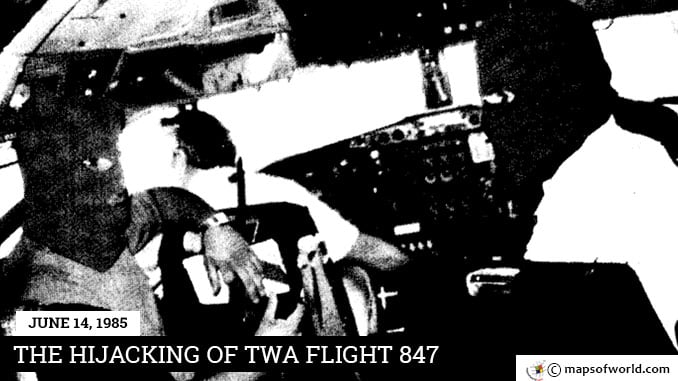At 10:10am local time in Athens, a trademark white-and-red Boeing 727 owned by TransWorld Airlines lifted off the runway bound for Rome carrying 145 passengers and a staff of eight crew. A little more than twenty minutes later, a serene two-hour flight to Rome turned into a nightmare for all on board – one that lasted more than two weeks past June 14, 1985 for some of the hostages. War rages, to some extent, at all times in the Middle East due to the complex issues surrounding the Arab-Israeli conflict. The hijacking of TWA Flight 847, though, happened during one of the most tense weeks in the region’s history: two planes had been captured by terrorists within the few days before – including one that exploded on the runway as the hijackers escaped – but neither created quite the same level of fear. “He has pulled a hand-grenade pin and is ready to blow up the aircraft if he has to. We must, I repeat, we must land at Beirut,” pilot John Testrake informed the Lebanese officials in the control tower. “We must land at Beirut. No alternative.” Despite tremendous reluctance – Lebanon was in the midst of a civil war and the airport had no security measures in place – the staff agreed to open the runway to TWA Flight 847. Once on the ground, the hijackers demanded fuel and, after threatening to blow up the plane, received a full load in exchange for releasing 19 passengers. The airliner departed in early afternoon for Algiers, landing only due to a plea from American President Ronald Reagan to his counterpart Chadli Bendjedid, the Algerian President. Grateful for the help Algerian diplomats had provided during the Iranian hostage crisis five years earlier, US officials believed it might be possible to negotiate a release of the remaining passengers with the plane on the ground in North Africa. They were wrong. After offloading another 20 passengers in exchange for more fuel, the weary pilot and crew were ordered to take to the skies, bound for Beirut once again. Landing late in the evening of the 14th, the hijackers took the terror to another level. Pulling a young American with a crew cut from his seat, the terrorists shot him in the head for being a US Marine responsible for “security blowups in Lebanon” and threw the body onto the tarmac. (US Navy diver Robert Stethem’s remains were picked up two hours later.) Soon after, a representative from Amal, one of several Lebanese militias in control of Beirut, came aboard to negotiate with the young men. Accompanied by a bodyguard, the official relayed a request that the airport’s lights be turned off. Knowing there wasn’t so much as a fence along the facility’s perimeter – someone could literally drive onto the runway if they chose – the terrorists were soon resupplied with arms and ammunition, joined by as many as a dozen confederates. In the process, the two Lebanese men who had taken the plane picked seven Americans with “Jewish-sounding” names from the hundred remaining passengers and handed them over to be held hostage in Beirut. Early the following morning, the hijackers announced intentions to take off once again. The pilot, asked where they would be headed, simply replied, “I don’t know.” Just before sunrise on Saturday, June 15th, TWA Flight 847 left Beirut once again and turned left for a return flight to Algiers. After a series of negotiations with Algerian officials, another 65 passengers were released. A third hijacker, detained in Greece after being left behind due to a lack of available seats on the plane, joined the team after being released by authorities in order to comply with his friends’ demands. As night fell in Algiers, the negotiation team presented the international community with a final set of ultimatums, including the release of more than 700 Shia prisoners from Israeli jails and the condemnation of bombers who killed 75 in a Lebanese neighborhood three months before. Without that, the hijackers promised to fly to an undetermined destination in the morning and destroy the plane, perhaps with the passengers still inside. Shortly after noon the following day, Captain John Testrake landed TWA Flight 847 in Beirut for a third and final time. Over the course of the next 24 hours, the hijackers plotted their final escape, requiring Amal chief Nabih Berri to house the remaining 40 passengers. As the mostly-male group left the plane, the pilot was seen on live television being interviewed from the cockpit window. A young security guard leaned through and held a gun to Testrake’s head, pulling him back through forcefully in full view of dozens of cameras. It remains the iconic image from the situation to this day. (Eager to get some time on screen, the 19-year-old hijacker had staged the scene – there were no bullets in the gun.) Over the course of the next 13 days, 39 passengers remained in captivity – one, after developing a heart condition, was released to the Red Cross for medical care. Eventually, on June 30th, the hostages were driven to Syria, where they flew to Rhein-Main Air Base in West Germany. Over the next few months, despite saying they had not bowed to pressure resulting from the hijacking, Israel released well over 700 Shia men and women from prison.
June 14, 1985 – The Hijacking of TWA Flight 847

